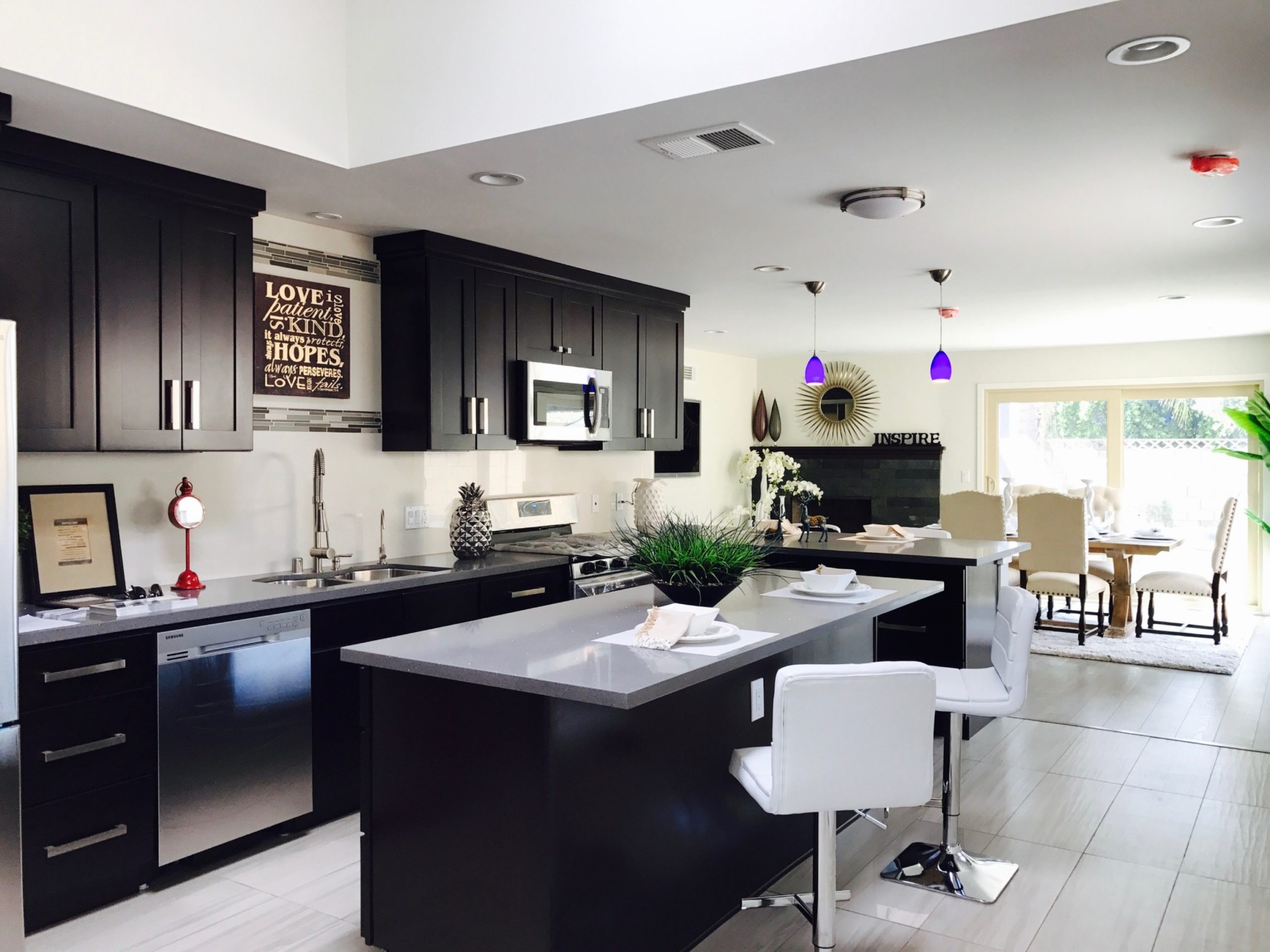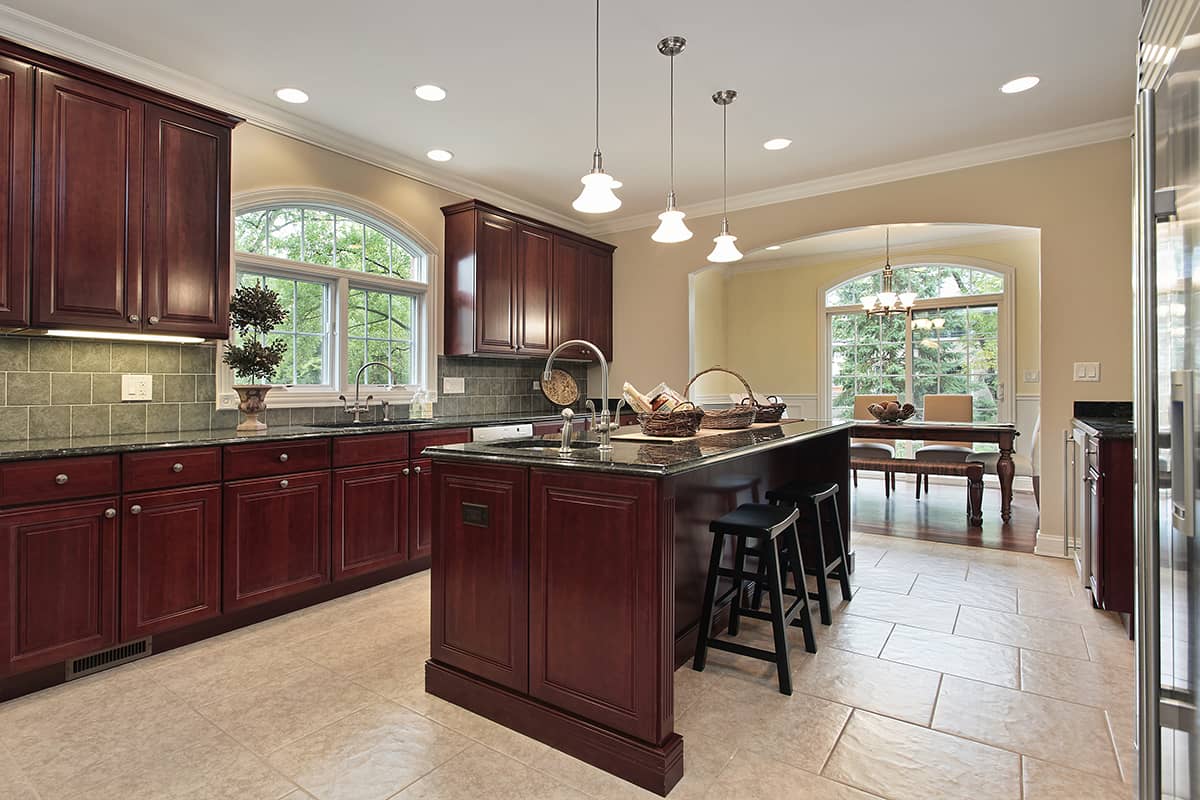Choosing the Right Flooring

Dark cabinets can create a dramatic and sophisticated look in any room, but choosing the right flooring is crucial to complementing their richness and ensuring a cohesive design. The wrong flooring can clash with the cabinets, making the space feel unbalanced or overwhelming.
Hardwood Flooring
Hardwood flooring is a classic choice for many homeowners, known for its durability, elegance, and timeless appeal. When paired with dark cabinets, hardwood flooring can create a sophisticated and warm ambiance.
- Light Hardwood Flooring: Lighter hardwood floors, such as maple, ash, or oak, create a striking contrast with dark cabinets, adding brightness and spaciousness to the room. For instance, a light oak floor with a natural finish would complement dark cherry cabinets, balancing the dark tones and creating a sense of visual harmony.
- Medium Hardwood Flooring: Medium-toned hardwood floors, like hickory or walnut, offer a more balanced and subtle contrast with dark cabinets. They provide a warm and inviting atmosphere while still maintaining a sense of visual interest. For example, a medium-toned hickory floor with a satin finish would complement dark espresso cabinets, creating a warm and cohesive design.
- Dark Hardwood Flooring: While dark hardwood floors, such as mahogany or ebony, might seem like a natural choice for dark cabinets, they can create a heavy and overwhelming effect. However, if used strategically, they can add a touch of drama and sophistication. For example, a dark mahogany floor with a high-gloss finish could complement dark walnut cabinets in a formal dining room, creating a luxurious and elegant ambiance.
Laminate Flooring
Laminate flooring is a cost-effective and versatile option that mimics the look of natural materials like hardwood, tile, or stone. It offers a wide range of styles and colors, making it easy to find a laminate floor that complements dark cabinets.
- Light Laminate Flooring: Light laminate floors with a wood-look finish can brighten up a room with dark cabinets, creating a spacious and airy feel. For instance, a light oak laminate floor with a matte finish would complement dark cherry cabinets, adding a touch of warmth and sophistication.
- Medium Laminate Flooring: Medium-toned laminate floors offer a more balanced contrast with dark cabinets, creating a cohesive and inviting atmosphere. For example, a medium-toned walnut laminate floor with a satin finish would complement dark espresso cabinets, adding a touch of elegance and warmth.
- Dark Laminate Flooring: Dark laminate floors can add a touch of drama and sophistication to a room with dark cabinets, but it’s important to choose a color that complements the cabinets without creating an overly heavy effect. For example, a dark mahogany laminate floor with a high-gloss finish could complement dark walnut cabinets in a formal dining room, creating a luxurious and elegant ambiance.
Tile Flooring
Tile flooring is a durable and stylish option that can withstand heavy traffic and moisture, making it suitable for kitchens, bathrooms, and entryways. When paired with dark cabinets, tile flooring can create a modern and sophisticated look.
- Light Tile Flooring: Light-colored tile floors, such as white, cream, or beige, can brighten up a room with dark cabinets, creating a spacious and airy feel. For instance, a white porcelain tile floor with a matte finish would complement dark espresso cabinets in a kitchen, adding a touch of elegance and sophistication.
- Medium Tile Flooring: Medium-toned tile floors, such as gray, taupe, or brown, offer a more balanced contrast with dark cabinets, creating a cohesive and inviting atmosphere. For example, a gray ceramic tile floor with a textured finish would complement dark walnut cabinets in a bathroom, adding a touch of warmth and sophistication.
- Dark Tile Flooring: Dark tile floors, such as black, charcoal, or dark brown, can add a touch of drama and sophistication to a room with dark cabinets, but it’s important to choose a color that complements the cabinets without creating an overly heavy effect. For example, a black porcelain tile floor with a high-gloss finish could complement dark mahogany cabinets in a formal dining room, creating a luxurious and elegant ambiance.
Vinyl Flooring
Vinyl flooring is a versatile and affordable option that comes in a wide range of styles and colors, mimicking the look of hardwood, tile, or stone. It offers a durable and water-resistant surface, making it suitable for kitchens, bathrooms, and high-traffic areas.
- Light Vinyl Flooring: Light-colored vinyl floors, such as white, cream, or beige, can brighten up a room with dark cabinets, creating a spacious and airy feel. For instance, a white vinyl plank floor with a wood-look finish would complement dark cherry cabinets in a kitchen, adding a touch of warmth and sophistication.
- Medium Vinyl Flooring: Medium-toned vinyl floors, such as gray, taupe, or brown, offer a more balanced contrast with dark cabinets, creating a cohesive and inviting atmosphere. For example, a gray vinyl plank floor with a wood-look finish would complement dark walnut cabinets in a bathroom, adding a touch of warmth and sophistication.
- Dark Vinyl Flooring: Dark vinyl floors, such as black, charcoal, or dark brown, can add a touch of drama and sophistication to a room with dark cabinets, but it’s important to choose a color that complements the cabinets without creating an overly heavy effect. For example, a black vinyl plank floor with a wood-look finish could complement dark mahogany cabinets in a formal dining room, creating a luxurious and elegant ambiance.
Color Palette and Design Considerations: Flooring With Dark Cabinets

Dark cabinets, with their rich and sophisticated appeal, can dramatically influence the overall color scheme of a room. The key is to balance the darkness with lighter elements to create a harmonious and inviting atmosphere.
Impact of Dark Cabinets on Color Schemes
Dark cabinets have a strong presence and can make a room feel smaller if not balanced correctly. To counter this, incorporating light colors on walls, ceilings, and furniture is essential. This creates a sense of spaciousness and allows the dark cabinets to stand out as a statement piece.
Visual Representation of Flooring Options
Imagine a living room with dark wood cabinets. The walls are painted a soft, warm white, creating a backdrop that highlights the cabinetry’s richness.
– Light Hardwood Flooring: A light-colored hardwood floor, such as maple or oak, creates a bright and airy feel, complementing the dark cabinets and the light walls. The contrast between the dark cabinets and the light floor visually expands the space.
– Medium-toned Hardwood Flooring: A medium-toned hardwood floor, like walnut or cherry, offers a more balanced look, providing a subtle contrast to the dark cabinets. This option creates a warm and inviting ambiance without overwhelming the room.
– Light-colored Tile Flooring: Light-colored tiles, such as white or cream, can bring a modern and clean aesthetic to the room. The contrast between the dark cabinets and the light tiles creates a visually striking and sophisticated look.
Popular Color Palettes for Dark Cabinets
Choosing the right color palette is crucial for achieving a cohesive and stylish look.
– Neutral Palette: This timeless palette features white, gray, and beige, creating a backdrop that allows the dark cabinets to be the focal point. A white or cream wall with gray furniture and light hardwood flooring provides a classic and elegant look.
– Warm Palette: Warm colors like beige, brown, and terracotta complement dark cabinets beautifully. For example, a warm beige wall with dark brown furniture and a medium-toned hardwood floor creates a cozy and inviting atmosphere.
– Cool Palette: Cool colors like blue, green, and gray can add a touch of sophistication and tranquility. A pale blue wall with dark gray furniture and light-colored tile flooring creates a serene and modern ambiance.
Lighting and Space Considerations

The interplay of light and dark in a room with dark cabinets and flooring is crucial for achieving a balanced and inviting ambiance. Strategic lighting can enhance the visual appeal and functionality of the space, while poor lighting can make the room feel cramped and overwhelming.
Impact of Lighting on Perception, Flooring with dark cabinets
Lighting significantly influences how dark cabinets and flooring are perceived. Natural light, for instance, can make dark colors appear less heavy, adding warmth and depth to the space. Conversely, artificial light can emphasize the darkness, potentially creating a gloomy or stark effect.
For example, a room with dark cabinets and flooring illuminated by warm-toned LED lights will appear more inviting and cozy compared to the same room lit by cool-toned fluorescent lights, which can make the dark elements seem colder and more imposing.
Flooring with dark cabinets – Dark cabinets can create a dramatic and sophisticated look, but finding the right flooring to complement them can be tricky. If you’re looking for a lighter and more airy feel, consider incorporating shades of blue and tan, which can bring a sense of calm and serenity.
For inspiration, check out blue and tan bedroom ideas for a chic and relaxing vibe. When it comes to flooring, a light wood or even a neutral tile can work beautifully with dark cabinets and blue and tan accents, creating a balanced and inviting space.